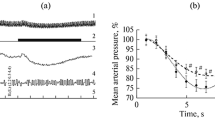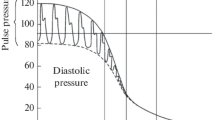Abstract
Chronic experiments were performed on rabbits to study changes in intraocular pressure, the coefficient of flow conductivity, and the chamber fluid minute volume during chronic emotional stress induced by long-lasting repeated electrical stimulation of the ventromedial nucleus of the hypothalamus alone and in combination with electrical stimulation of the locus ceruleus and central gray matter of the periacqueductal matter. Stimulation of the ventromedial nucleus of the hypothalamus was accompanied by an increase in intraocular pressure, an increase in the production of eye chamber fluid, and a decrease in the coefficient of flow conductivity. Electrical stimulation of the locus ceruleus and central gray matter of the periacqueductal matter led to less marked increases in intraocular pressure. Combined stimulation of the hypothalamus and locus ceruleus led to normalization of intraocular pressure due to a reduction in the volume of chamber fluid and an increase in the coefficient of flow conductivity.
Similar content being viewed by others
REFERENCES
T. I. Belova, E. L. Golubeva, and K. V. Sudakov, Homeostatic Functions of the Locus Ceruleus (Blue Spot), [in Russian], Nauka, Moscow (1980).
A. Ya. Bunin, Hemodynamics of the Eye and Methods for Its Investigation [in Russian], Meditsina, Moscow (1971).
A. Ya. Bunin, “Metabolic factors in the pathogenesis of glaucoma,” in: Glaucoma: Proceedings of the All-Russian Scientific-Applied Conference “Glaucoma at the Millennium: Summary and Perspectives [in Russian], Moscow (1999), pp. 9–12.
Ya. Buresh, M. Petran', and I. Zakhar, Electrophysiological Study Methods [in Russian], IL, Moscow (1962).
I. G. Bryndina, “Intraocular pressure in conditions of prolonged stimulation and electrical lesioning of the reticular formation of the midbrain,” Oftal'mol. Zh., 6, 361–364 (1985).
G. E. Danilov and Kh. V. Khalliulina, “Changes in intraocular pressure after local administration of catecholamines into the hypothalamus,” Fiziol. Zh. SSSR, 67,No. 10, 1487–1492 (1981).
S. B. Egorkina and G. E. Danilov, “Changes in intraocular pressure during experimental treatments to the amygdaloid complex,” Fiziol. Zh. SSSR, 71,No. 6, 714–718 (1985).
L. S. Isakova and G. E. Danilov, “Changes in blood hormone levels in chronic electrical stimulation of the hypothalamus and amygdaloid complex,” Fiziol. Zh. SSSR, 77,No. 4, 90–95 (1991).
S. F. Kal'fa, “Pathogenesis of primary glaucoma,” Oftal'mol. Zh., 2, 7–11 (1952).
L. T. Kashintseva, I. N. Mikheitseva, and O. P. Kopp, “Membrane-receptor, cellular, and calcium mechanisms of development of primary open-angle glaucoma,” in: Glaucoma: Proceedings of the All-Russian Scientific-Applied Conference “Glaucoma at the Millennium: Summary and Perspectives [in Russian], Moscow (1999), pp. 9–12.
A. V. Myagkov, “Changes in intraocular pressure and the hydrodynamics of the eye during intracerebral administration of adrenaline,” Oftal'mol. Zh., 4 (2000).
A. P. Nesterov, Glaucoma [in Russian], Meditsina, Moscow (1995).
A. P. Nesterov, A. Ya. Bunin, and L. A. Katsnel'son, Intraocular Pressure. Physiology and Pathology [in Russian], Nauka, Moscow (1974).
Author information
Authors and Affiliations
Rights and permissions
About this article
Cite this article
Myagkov, A.V., Danilov, G.E. & Fatykhov, I.R. The Correcting Influence of the Locus Ceruleus on Ophthalmic Hypertension of Hypothalamic Origin. Neurosci Behav Physiol 34, 97–100 (2004). https://doi.org/10.1023/B:NEAB.0000003252.77752.40
Issue Date:
DOI: https://doi.org/10.1023/B:NEAB.0000003252.77752.40




